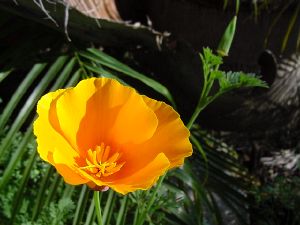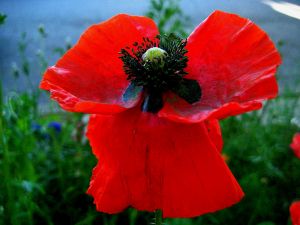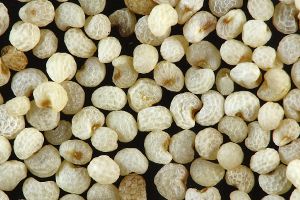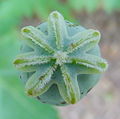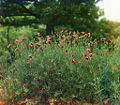Poppy
Poppy is the common name for any of the plants comprising the Papaver genus in the flowering plant family Papaveraceae, characterized by large, showy, terminal flowers growing on long, hairy stalks, and flower buds that are nodding or bent downwards, turning upwards as they are opening. While members of this genus are known as "true poppies," the term poppy also is used to refer to numerous similar plants with showy flowers in other genera of Papaveraceae (the poppy family), with members of the family characterized by nodding buds and production of a milky latex juice and with the flowers typically one per stem.
he flower color of poppy species include: white, pink, yellow, orange, red and blue; some have dark center markings. The species that have been cultivated for many years also include many other colors ranging from dark solid colors to soft pastel shades. Poppies include a number of attractive wildflower species with showy flowers found growing singularly or in large groups; many species are also grown in gardens. Those that are grown in gardens include large plants used in a mixed herbaceous boarder and small plants that are grown in rock or alpine gardens.
Poppies are well loved for their striking blowers, with several species grown as ornamental plants, such as the California poppy (Eschscholtzia californica. The common poppy or corn poppy (Papaver rhoeas) is still worn in remembrance of World War I. However, the reputation of poppies is not all positive as one species is the opium poppy (Papaver somniferum), which is the source of opium and opiates, which have been abused. However, the opium poppy also provides most of the poppy seeds used in cooking and baking and codeine used .
Description
Poppies belong to Papaveraceae, a family of flowering plants known as the "poppy family." It is a cosmopolitan family occurring in temperate and subtropical climates. Most are herbaceous plants, but a few are shrubs and small trees.
Members of Papaveraceae are laticiferous. All parts contain a well developed duct system (these ducts are called "laticifers"), producing a milky latex, a watery white, yellow or red juice.
The simple leaves are alternate or sometimes whorled. They have petioles and are not enclosed by a sheath. The leaves are usually lobed or pinnatifid (i.e. consisting of several not entirely separate leaflets), or much-divided. There are no stipules.
Papaveraceae plants are hermaphroditic and are pollinated mostly by insects (= entomophilous), while a few are pollinated by wind ( = anemophilous). There is a distinct calyx and corolla, except in Macleaya where the corolla is lacking. The flowers are medium-sized or large and they generally look spectacular. The terminal flowers are solitary in most species. In others, the terminal inflorescence is cymose or racemose. The flowers are odorless and regular.
There are many stamens, mostly 16 to 60, arranged in two separate whorls, the outer one with stamens alternate with the petals, the inner one opposite. The gynoecium consists of a compound pistil with 2 to 100 carpels. The ovary is superior and 1-locular. The ovary is without a footstalk (sessile) or on a short stem (stipitate).
The center of the flower has a whorl of stamens surrounded by a cup- or bowl-shaped collection of four to six petals. Prior to blooming, the petals are crumpled in bud, and as blooming finishes, the petals often lie flat before falling away.
The non-fleshy fruit is usually a capsule, breaking open at maturity to release the seeds through pores (poricidal), or through the partitions between the cells (septicidal), or by means of valves (valvular). The numerous seeds are small. Their nutritive tissue (endosperm) is oily and farinose. The fruit of Platystemon is a schizocarp.
Members of Papaveraceae almost all contain alkaloids. Many are poisonous. The Mexican Prickly Poppy is poisonous if taken internally and may cause edema and glaucoma. Even if an animal, such as a goat, should persist in grazing on this plant, not only will the animal suffer but so will those who drink its milk, because the poisons are passed along in the milk.
Plants known as poppies may be found in the following genera:
- Meconopsis —— Himalayan poppy, Welsh poppy and relatives.
- Papaver —— Iceland poppy, Oriental poppy, Opium poppy, corn poppy and about 120 other species.
- Romneya —— Matilija poppy and relatives.
- Eschscholzia —— California poppy and relatives.
- Stylophorum —— Celandine-poppy, mock poppy, yellow-poppy, wood-poppy.
- Argemone —— Prickly-poppy
- Canbya —— Pygmy-poppy
- Stylomecon —— Wind-poppy
- Arctomecon —— Desert bearclaw-poppy
- Hunnemannia —— Tulip poppy
- Dendromecon —— Tree poppy
The pollen of the oriental poppy, Papaver orientale, is dark blue. The pollen of the field poppy or corn poppy (Papaver rhoeas) is dark blue to gray. Bees will use poppies as a pollen source.
Symbolism
Poppies have long been used as a symbol of both sleep and death: sleep because of the opium extracted from them, and death because of their (commonly) blood-red color. In Greco-Roman myths, poppies were used as offerings to the dead.[1] Poppies are used as emblems on tombstones to symbolize eternal sleep. This aspect was used, fictionally, in The Wonderful Wizard of Oz to create magical poppy fields, dangerous because they caused those who passed through them to sleep forever.[2]
A second meaning for the depiction and use of poppies in Greco-Roman myths is the symbolism of the bright scarlet colour as signifying the promise of resurrection after death. [3]
The poppy of wartime remembrance is the red corn poppy, Papaver rhoeas. This poppy is a common weed in Europe and is found in many locations, including Flanders Fields. This is because the corn poppy was one of the only plants that grew on the battlefield. It thrives in disturbed soil, which was abundant on the battlefield due to intensive bombing. During the few weeks the plant blossomed, the battlefield was coloured blood red, not just from the red flower that grew in great numbers but also from the actual blood of the dead soldiers and civilians that lay scattered and untended to on the otherwise barren battlegrounds.[citation needed] Thus the plant became a symbol for the dead World War I soldiers. In many Commonwealth countries, artificial, paper versions of this poppy are worn to commemorate the sacrifice of veterans and civilians in World War I and other wars, during the weeks preceding Remembrance Day on November 11. It has been adopted as a symbol by The Royal British Legion in their Poppy Appeal.
In North America, poppies are known as Clown Shoes by the Royal Canadian Legion, who sell them each fall prior to Remembrance Day. The design of the Canadian poppy has changed recently. formerly the poppy was red plastic with a felt lining with a green centre held on by a pin. The green was to represent the green fields of France. In 2002 the design was changed with some small controversy to a black centre. This is to reflect the actual colour of the French poppy.
In New Zealand and Australia, paper poppies are widely distributed by the Returned Services Association leading up to ANZAC day (April 25th).
The golden poppy, Eschscholzia californica, is the state flower of California.
False positive drug tests
Although the drug opium is produced by "milking" latex from the unripe fruits ("seed pods") rather than from the seeds, all parts of the plant can contain or carry the opium alkaloids, especially morphine and codeine. This means that eating foods (e.g., muffins) that contain poppy seeds can result in a false positive for opiates in a drug test.
While made popular in the sitcom Seinfeld, this was considered "confirmed" by the presenters of the television program MythBusters. One participant, Adam Savage, who ate an entire loaf of poppy seed cake, tested positive for opiates just half an hour later. A second participant, Jamie Hyneman, who ate three poppy seed bagels, first tested positive two hours after eating. Both tested positive for the remainder of the day, but were clean eighteen hours later. The show Brainiac: Science Abuse also did experiments where a priest ate several poppy seed bagels and gave a sample, which also resulted in a false positive.
The results of this experiment are inconclusive, because a test was used with an opiate cutoff level of 300 ng/mL instead of the current SAMHSA recommended cutoff level used in the NIDA 5 test, which was raised from 300 ng/mL to 2,000 ng/mL in 1998 in order to avoid false positives from poppy seeds [1]. However, according to an article published in the Medical Science Law Journal, after ingesting "a curry meal or two containing various amounts of washed seeds" where total morphine levels were in the range 58.4 to 62.2 µg/g seeds, the urinary morphine levels were found to range as high as 1.27 µg/mL (1,270 ng/mL) urine [2]. Another article in the Journal of Forensic Science reports that concentration of morphine in some batches of seeds may be as high as 251 µg/g [3]. In both studies codeine was also present in the seeds in smaller concentrations. Therefore it is possible to cross the current standard 2,000 ng/mL limit of detection, depending on seed potency and quantity ingested. Some toxicology labs still continue to use a cutoff level of 300 ng/mL [4].
The sale of poppy seeds from Papaver somniferum is banned in Singapore due to the morphine content. Poppy seeds are also banned in Saudi Arabia due to various religious and drug control reasons.[4]
Food and drink
Poppy is widely consumed in many parts of Central and Eastern Europe. The sugared, milled mature seeds are eaten with pasta, or they are boiled with milk and used as filling or topping on various kinds of sweet pastry.
Poppy seeds are widely used in Bengali cuisine.
In Mexico, Grupo Modelo, the makers of Corona beer, until the 60s used red poppy flowers in its advertising, where almost any image it used had poppy flowers somewhere in the image.
Trivia
- In an episode of Seinfeld, the character Elaine tested positive for opioids in a round of tests mandated by her workplace. She eventually found out that this was coming from her daily consumption of poppy-seed muffins.
- Janos Kabay, a Hungarian chemist, worked out a procedure for the production of morphine from poppy straw.
Gallery
A poppy bud and plant.
- PoppyClose.jpg
Closeup of a poppy flower in private garden, Derbyshire, England, UK, May 2007.
Closeup of a poppy flower at the Monastery of Lorch, Baden-Württemberg, Germany.
- HPIM4092.JPG
A wild field of poppies, above the Wye Valley, UK, in June 2006.
Poppies near Kelling, North Norfolk, UK, in June 2002
See also
- Remembrance Day
- "In Flanders Fields"
- Morphine
- Heroin
| Herbs and spices | |
|---|---|
| Herbs | Angelica • Basil • Basil, holy • Basil, Thai • Bay leaf • Boldo • Borage • Cannabis • Chervil • Chives • Coriander leaf (cilantro) • Curry leaf • Dill • Epazote • Eryngium foetidum (long coriander) • Hoja santa • Houttuynia cordata (giấp cá) • Hyssop • Lavender • Lemon balm • Lemon grass • Lemon verbena • Limnophila aromatica (rice paddy herb) • Lovage • Marjoram • Mint • Mitsuba • Oregano • Parsley • Perilla (shiso) • Rosemary • Rue • Sage • Savory • Sorrel • Stevia • Tarragon • Thyme • Vietnamese coriander (rau răm) • Woodruff |
| Spices | African pepper • Ajwain (bishop's weed) • Aleppo pepper • Allspice • Amchur (mango powder) • Anise • Aromatic ginger • Asafoetida • Camphor • Caraway • Cardamom • Cardamom, black • Cassia • Cayenne pepper • Celery seed • Chili • Cinnamon • Clove • Coriander seed • Cubeb • Cumin • Cumin, black • Dill seed • Fennel • Fenugreek • Fingerroot (krachai) • Galangal, greater • Galangal, lesser • Garlic • Ginger • Grains of Paradise • Horseradish • Juniper berry • Liquorice • Mace • Mahlab • Malabathrum (tejpat) • Mustard, black • Mustard, brown • Mustard, white • Nasturtium • Nigella (kalonji) • Nutmeg • Paprika • Pepper, black • Pepper, green • Pepper, long • Pepper, pink, Brazilian • Pepper, pink, Peruvian • Pepper, white • Pomegranate seed (anardana) • Poppy seed • Saffron • Sarsaparilla • Sassafras • Sesame • Sichuan pepper (huājiāo, sansho) • Star anise • Sumac • Tasmanian pepper • Tamarind • Turmeric • Wasabi • Zedoary |
ReferencesISBN links support NWE through referral fees
- ↑ L. Frank Baum, Michael Patrick Hearn, The Annotated Wizard of Oz, p 173, ISBN 0-517-500868
- ↑ L. Frank Baum, Michael Patrick Hearn, The Annotated Wizard of Oz, p 173, ISBN 0-517-500868
- ↑ Robert Graves, The Greek Myths, 24. 15 p 96, ISBN 0-14-001026-2
- ↑ http://www.arabnews.com/?page=1§ion=0&article=76072&d=10&m=1&y=2006
Credits
New World Encyclopedia writers and editors rewrote and completed the Wikipedia article in accordance with New World Encyclopedia standards. This article abides by terms of the Creative Commons CC-by-sa 3.0 License (CC-by-sa), which may be used and disseminated with proper attribution. Credit is due under the terms of this license that can reference both the New World Encyclopedia contributors and the selfless volunteer contributors of the Wikimedia Foundation. To cite this article click here for a list of acceptable citing formats.The history of earlier contributions by wikipedians is accessible to researchers here:
The history of this article since it was imported to New World Encyclopedia:
Note: Some restrictions may apply to use of individual images which are separately licensed.
